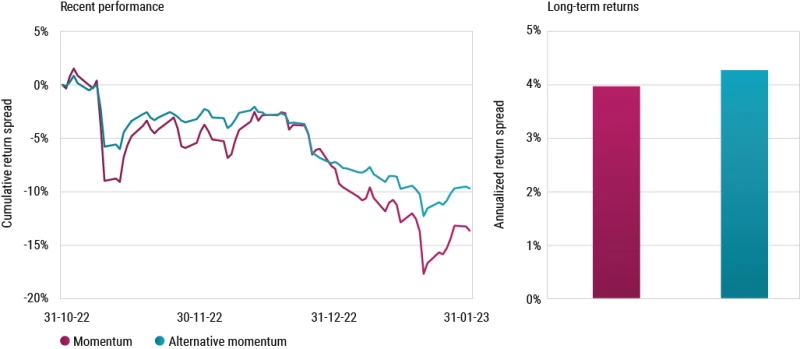Price momentum refers to the tendency for assets that have outperformed or underperformed over a recent period to continue following the same trend in the future. Despite generating strong long-term returns, this approach can also experience significant drawdowns. These ‘momentum crashes’ often occur after bear markets and coincide with rebounding markets. The recent drawdowns in November 2022 as well as January and February 2023 are prime examples of this phenomenon, as illustrated in Figure 1.
Figure 1 | Recent performance and long-term returns for momentum strategies

Source: I/B/E/S, Refinitiv, Robeco. The figure displays the return spread between the top and bottom quintile portfolios based on price momentum and an alternative momentum composite. The price momentum is calculated as the 12-1 month price return, while the alternative momentum composite includes 12-1 month residual momentum, 3-month EPS FY1 revision signals, and 6-month news sentiment data. The investment universe consists of MSCI Developed Index constituents. The portfolios are equally weighted, rebalanced monthly and constructed in a region and sector neutral manner. The left and right charts illustrate the results for the sample period of 31 October 2022 to 14 February 2023, and January 2001 to January 2023, respectively.
Discover the value of quant
Subscribe for cutting-edge quant strategies and insights.
During this period, hopes for an end to monetary tightening and a potential soft landing for the US economy were driven by lower-than-expected inflation numbers and a less hawkish US Federal Reserve. This resulted in the revival of the worst-performing assets from the previous year and negative returns for the momentum factor, while deep value factors did well.1
Our research, however, shows that alternative definitions of momentum – such as residual momentum2, analyst forecast revisions and news sentiment3 – can mitigate these momentum crashes without sacrificing long-term returns. As shown in the left-hand side chart of Figure 1, these alternative definitions of momentum did suffer less during these recent episodes.
The question that remains is whether investors must forgo long-term returns to reduce crash risk, or put differently, whether the momentum premium is a reward for exposure to crash risk. The simple answer is no, as depicted by the right-hand side chart of Figure 1. In fact, we observe that the alternative momentum composite actually exhibits slightly higher long-term returns.
In conclusion, while price momentum is pervasive and can play an excellent role as a diversifying factor when paired with value strategies, its susceptibility to occasional momentum crashes should not be overlooked. On the other hand, alternative definitions of momentum such as residual momentum, analyst forecast revisions and news sentiment offer a solution by providing similar long-term returns, with lower volatility and milder crashes.
Footnotes
1 Tsekova, D. and Lee, J., February 2023, “Quant funds shed billions as Wall Street’s hottest trends falter”, Bloomberg.
2 Blitz, D., Huij, J., and Martens, M., June 2011, “Residual momentum”, Journal of Empirical Finance.
3 Marchesini, T., and Swinkels, L., July 2019, “Integrating news sentiment in quant equity strategies”, Robeco article.




















